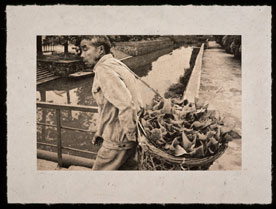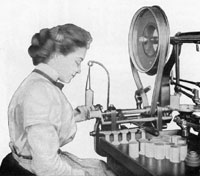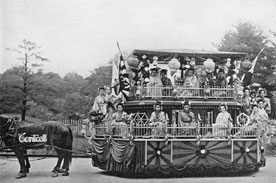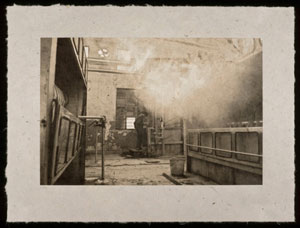
Exhibits Events Past Program Highlights 
|


Northampton Silk Threads:
The China Connection
An Exhibit by Stan Sherer & Marjorie Senechal
May 1 - June 29, 2013
Opening Reception: Friday, May 10th, 5 to 8 pm
 |
Opening May 1, 2013, is the exhibit Northampton Silk Threads: The China Connection featuring photographs by Stan Sherer and interpretive text by Marjorie Senechal. Northampton’s century of silk echoes in street names, a refurbished mill, an evocative diner, and gnarled mulberry trees bearing witness to the industry that was once Northampton’s largest. This exhibit juxtaposes historical photographs, posters, and artifacts from the collection of Historic Northampton with Stan Sherer’s photographs, printed on handmade rice paper, of silk-raising in contemporary China. At left, is a photograph of a farmer bringing mulberry leaves to feed silkworms, in Zhenziang, photographed in 2002.
 |
Winding Silk Onto Spools Nonotuck Silk Company |
Silk thread and Northampton once were synonyms. In the first half of the 19th Century, silk was an agricultural crop. Emily Dickinson’s father chaired the New-England Silk Convention; Dr. Daniel Stebbins, Yale class of 1788, grew mulberry trees on every inch of his Pomeroy Terrace estate (missionary friends in China sent him silkworm eggs in return for his support of their work). When manufacturing demands outstripped the silkworms, the local industry abandoned its cocooneries and turned to China, silk masters for millennia. But Chinese raw silk, reeled by hand, proved unsuited to the new machine age. Ever-optimistic, they sent American machines to China, one of them invented by Northampton’s own Harrison Holland. Shown above, is photograph of a woman winding silk onto spools which was published in the booklet, Silk: Its Origin, Culture and Manufacture, by the Nonotuck Silk Company.
 |
Nonotuck Silk Company Float, 1904 |
Japan soon replaced China as Northampton’s supplier and remained its partner up to the Great Depression, when the American silk industry collapsed. Today China still raises silk from scratch. In 2002 and 2004 Stan Sherer and Marjorie Senechal traveled there as guests of the Sericultural Research Institute of the Chinese Academy of Agricultural Sciences to understand what Northampton’s visionaries had tried to do and why they failed. Join photographer Stan Sherer and historian of science Marjorie Senechal for the opening reception of Northampton Silk Threads: The China Connection on Friday, May 10, 2013 from 5 to 8 pm as part of Northampton's Arts Night Out.
 |
Steaming Silk Cloth, Zhenziang, 2002 |
Stan Sherer is an independent photographer and fine art digital printmaker in Northampton. Sherer was a Fulbright Scholar in Albania in 1994; he served on the Fulbright photography national screening committee from 2003-2006. He has received fellowships and grants from the Massachusetts Foundation for the Humanities, the Massachusetts Cultural Council, and the National Endowment for the Humanities. The exhibition Founding Farms, a profile of Massachusetts’s oldest family farms, toured the country from 1990-1997. Sherer has authored four books of photographs including Founding Farms, and Long Life to Your Children! A Portrait of High Albania. He earned a Master of Fine Arts degree in printmaking at the University of Massachusetts in 2006. His most recent solo exhibitions are “Vermont Farmsteads” at the Vermont Center for Photography and “Faces of Northampton, Enduring and Forgotten: Main Street, 125 Years” at Historic Northampton. He has taught digital photography at Hampshire College, Mt. Holyoke College, The University of Massachusetts, and The University of Hartford.
Contents Historic Northampton.